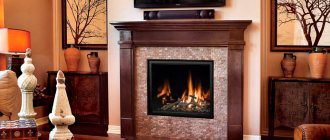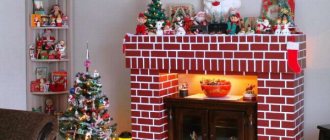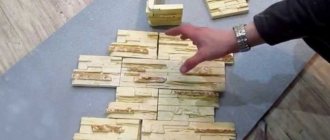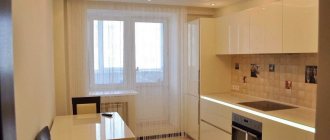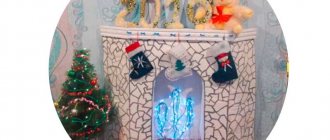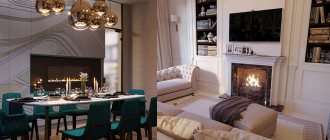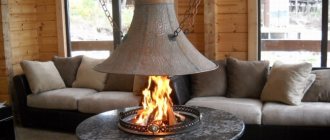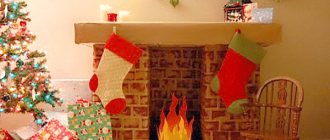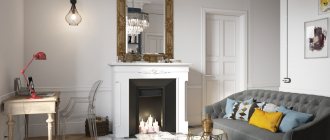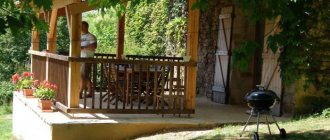Modern people get no less pleasure from contemplating living fire than their ancient ancestors. Apparently, genetic memory still exists. But in a cottage with all the amenities, and even more so in an apartment, it is difficult to set up a fireplace, and there is no need for it. But you can make a decorative fireplace from plasterboard that does not need a chimney. You can’t make a real fire in it, but there are many other ways to imitate a living flame and enjoy evenings of cozy family gatherings around the hearth.
A decorative portal with a built-in electric fireplace looks like a real one Source stihi.ru
Finishing a fireplace with plasterboard: doing it right
The use of plasterboard in finishing a fireplace
The simplest option for arranging a fireplace is to decorate the fireplace with plasterboard yourself. This is the topic that will be discussed today. This is a simple job that you can do yourself, without resorting to outside help, which will significantly reduce the cost of the work. You can watch photos and videos, choose a design design. Instructions for completing this work will be given.
Fireplace location
You need to start by choosing a place and taking measurements. The plasterboard structure is not mobile; it is rigidly fixed to the wall. It is impossible to move such a structure without completely dismantling it, so you need to immediately determine where to make a decorative fireplace so that it does not disturb anyone.
Another important point when choosing a place to imitate a hearth is its central location in the interior. The entire composition of the room will be built around the burning fire and its frame. It is advisable to choose an area that will allow you to arrange furniture without interference, taking into account this rule. People who are passionate about Feng Shui should pre-establish a favorable zone for installing the future layout.
When a suitable location has been found, you need to measure the length and width of the future portal. This is necessary to calculate the amount of materials used during installation. According to the determined dimensions, make scale drawings to determine what parts will be required during assembly. Draw a sketch of the portal design.
Installing a plasterboard fireplace
The fireplace can be decorated using different materials, for example, ceramic tiles (see Ceramic tiles for fireplaces and stoves - make a choice), but today we will look at how a fireplace can be decorated with plasterboard. This is the simplest option that can be easily implemented with your own hands. But like any job, it requires some preparation. The necessary requirements must be met. You will receive useful tips for doing your work.
Tools and materials
Before starting installation work with your own hands, you should purchase everything you need so as not to be distracted during installation:
- For measurements you will need a ruler, tape measure and square;
- To properly install the vertical placement check, you will need a plumb line;
- The building level will help determine parallelism;
- pencil and construction knife;
- fine-tooth hacksaw;
- an impact drill will help make the frame;
- screwdriver;
- plasterboard sheets;
- dowels;
- rack profile.
Attention! Before starting work, it is worth bringing sheets of drywall to the room about a day before. They should be placed on a flat surface and a weight should be placed on top. The fact is that the material may be uneven. In this form, it will acquire the desired shape and get used to the temperature.
Preparing the layout and location
As for the location of the fireplace, experts give some recommendations on this issue:
- To make the fireplace look beautiful and real, you should think about a decorative chimney (see Choosing a chimney - which one suits us best), which should fit into the interior and look against the background of the room. It can also be made from plasterboard.
- First, you should draw the future fireplace on paper. Enter all dimensions.
- Provide a fireplace space, which is a must. If it is not there, then you should think about a wall structure.
- Before you start working with your own hands, you should draw a fireplace on the wall and attach a profile along the lines. See how the design will look in its natural size.
Preparing the site
Once a location has been chosen and the material has been purchased, you can begin to do the work yourself. We will give general recommendations that should be followed when performing any configuration. Fundamentally they are the same for all options:
- The first step is to properly prepare the installation site. This should be a level area and should be cleared of debris. The plane must be rigid and support the weight of the entire structure. If you have a wooden floor and the fireplace is quite heavy, then you should pour a concrete platform; the finishing of this area can be done with ceramic tiles.
- To fill the base with your own hands, first make the formwork so that the platform itself is at least 100 mm high from the floor surface;
- After this, care should be taken to protect the walls from temperature. For this, aerated concrete slabs are most often used, which serve as reliable protection.
Attention! Measure aerated concrete slabs well. They must be completely covered with drywall after installation. Once the frame is made, it will be almost impossible to fix everything.
- When making the base, you should immediately pay attention to the parallelism of the plane. The fireplace will be mounted on it, so any inaccuracies will be reflected in the configuration. Therefore, use a building level.
- To make a plasterboard box with your own hands, you can use both a metal profile and a wooden beam. If you choose the second option, then do not forget to treat it with antiseptics that are available in retail stores. They will extend the life of the structure and protect against the formation of rot and mold. Remember that after processing the material must dry completely.
Frame installation
This is the first step in installing a fireplace. The main thing in this matter is to fully maintain the geometric shape. Remember that a deviation of one mm can result in centimeters in the final finishing. Do everything very carefully. So:
- First of all, we attach the support frame to the wall. To do this, first cut the profile to the required size and make the fastening. For a wooden surface, you can get by with ordinary self-tapping screws. If the plane is made of concrete or brick, then the hole should be made using a hammer drill. And use a dowel to connect.
Attaching the frame to the wall
Attention! When purchasing dowels, you should avoid purchasing kits. The necessary pacifiers and screws for them with a cross-section larger than the diameter by a couple of mm. Only in this option will you ensure the reliability and required rigidity of the structure.
- Now we begin to install the racks. To do this, we cut the profile to size, install it, and fasten it using self-tapping screws. When installing, the corners should be checked with a square and the parallelism of the planks should be checked with a building level.
- After installing the frame, everything should be carefully checked with a meter. The configuration must be perfect.
- Now we cut the drywall to size and attach it to the frame using self-tapping screws. There is one nuance here: if you have a three-dimensional structure, then do the sheathing in two layers.
Attention! It is desirable that the finishing be done in solid sheets of material. If this does not work, then auxiliary slats should be made in the frame. Drywall is connected only on a rigid plane. After this, do not forget to treat the seam with a serpyanka.
Attaching drywall to the frame
- Now we install the firebox. In the fireplace insert, finishing is done in exactly the same way as described above. Just for safety reasons, it is worth covering the back and side walls with heat-reflecting screens. Then the fire brigade won’t be able to attach themselves either.
Fireplace finishing
Now the finished structure must be finished. Before this, you need to seal all the joints between the sheets and the fastening points. It should be even and smooth. All cracks must be closed. So:
- Take the dry mixture and pour it into a container. A plastic paint bucket works best.
- Add water and stir at the same time.
- After this, we need to make a homogeneous mass without lumps. To do this, use a drill with an attachment. This is what will allow you to achieve homogeneity of the mass. Bring the solution to the state of sour cream.
- After this, apply the mixture to the drywall with a spatula. Waiting for it to dry. This was the basis.
- After this, we also apply another layer, only thinner, and take the spatula wider. We make the plane perfectly flat.
- After this, we take the grout mesh and treat the surface. Where shells have appeared, they should be rubbed off or a layer of solution should be added and, after drying, processed again.
Direct assembly of the main frame
When compared with other furniture options, the TV niche has a separate assembly structure. The only similarity is that it has a main element and additional details of a special figure that have a formative function.
The assembly process itself is carried out as follows:
1. Installation of guide profiles. The most advantageous option for optimal load is 50 mm.
2. Approximately 4 rows of guides are nailed to the rough version of the plane, and in the case of continuous sheathing - to hidden plasterboard profiles.
3. An ordinary small podium is mounted at the foot.
4. If there are side columns, it is recommended to duplicate the guides, between which it is necessary to insert special jumpers of the required length; they will be the ones who will determine the depth of the excavation.
There are several profile connection options:
- with the help of bent wings”;
- use of “crab”;
- using a special insert that serves as a possible profile extension;
- The best option is cutters.
One more point should be taken into account: before sewing the frame, it is recommended to lay all the wires in the internal plane of the structure.
Cladding the fireplace with plasterboard: step-by-step work
Cladding fireplaces with plasterboard is simple. It is not particularly difficult and can be done by anyone who wants to do it themselves.
How to install a fireplace
Cladding a fireplace with plasterboard requires some skill.
You will have to use:
- With a ruler.
- Square.
- Plumb to check the verticality of the fireplace.
- A level that will show parallelism.
- With a tape measure.
- With a pencil.
- Knife for construction.
- A hacksaw with fine teeth.
- Impact drill.
- Screwdriver for screws.
Advice. Drywall sheets must be flat. For this purpose, a load is placed on them.
Comparison table between a plasterboard fireplace and a marble fireplace:
Plasterboard fireplace
Marble fireplace
Does not require large financial outlays. It can be done quickly.
This fireplace is quite expensive. Its production will take a long time.
It is characterized by mobility and quick dismantling.
A marble fireplace is very difficult to disassemble.
It is safe because there is no open heating source.
It poses a certain danger, as a spark may hit the floor if installed incorrectly.
A plasterboard fireplace can be installed even in a small room.
A marble fireplace requires a lot of space.
A person will never get burned on a plasterboard fireplace. Furniture will also not be damaged.
Hot coals can jump out of a marble fireplace, which pose a danger to others and can ruin the polish of your furniture.
Choosing a location
Many masters share their valuable recommendations regarding this issue.
Advice. For greater effect from the fireplace, you should definitely consider the presence of a decorative chimney that can complement the design of your apartment. Its basis is also drywall.
At the initial stage, make a drawing of your fireplace on paper:
- Determine the length, width and height of the future product.
- Take into account the space around the fireplace.
- This nuance is required. If there is no space, then you should resort to making a wall-mounted structure.
- Before you begin your work, draw the lines of the fireplace on the wall. A profile is attached to the lines.
This way you can make sure how the size of this design fits your interior.
How to prepare a place for a fireplace
The installation site must be a flat area, completely clear of debris.
The plane must be rigid enough to support the mass of the fireplace:
- If the floor in your apartment is made of wood, and the weight of the fireplace is quite large, then it is recommended to pour a concrete platform.
- For the base, formwork is made in such a way that the height of the platform is at least 100 mm from the floor level.
- Next, you should take into account the protection of the walls from high temperatures.
- For this purpose, as a rule, they resort to the use of aerated concrete slabs, which provide high-quality protection.
Advice. Take careful measurements of aerated concrete slabs. They must be completely covered with plasterboard sheets after installing the fireplace. Once the fireplace frame is ready, you will not be able to correct the measurement error.
- During the manufacturing process of the base, attention is paid to ensuring that the planes are parallel. The fireplace is mounted on a base, so any irregularities will affect the configuration. Be sure to use a level for construction.
- To make the box, you can resort to using a metal profile or a wooden beam. If you choose the latter, treat it with an antiseptic available in retail sales.
- Antiseptics help extend the service life of the configuration and will serve as reliable protection against rot and mold.
Remember! After processing, the material must dry thoroughly!
How to install the frame
The main thing during installation is compliance with the geometric shape.
Remember that even the slightest deviation from the norm will result in an inaccuracy in centimeters for you at the last stage of finishing.
Carry out your work very carefully:
- A frame is attached to the wall for support. For this purpose, the profile of the required size is initially cut and fasteners are made. For surfaces made of wood, you can use self-tapping screws. If the plane is brick or concrete, then the hole is made using a hammer drill. Dowels are used for connection.
- When attaching the frame to the wall, please note that you should not purchase sets of dowels. You need pacifiers and self-tapping screws, the cross-section of which is several millimeters larger than their diameter.
- Only if you follow this rule will you achieve rigidity and reliability of fastening.
In order to install the racks, the profile size should be cut. Fastening is done using self-tapping screws.
- During installation, angles are checked using a square, and parallelism is checked using a construction level. The shape of the fireplace must be impeccable.
- Starts cutting drywall to size. We attach it to the frame using self-tapping screws. A mandatory rule must be followed here.
- If your fireplace is three-dimensional, then lining the fireplace insert with plasterboard is carried out in two layers. Make finishing only from solid sheets.
- If you did not take this nuance into account, you will have to make auxiliary slats in the frame. The drywall connection is carried out only on a rigid plane. The seam is processed using a serpyanka.
The finishing of the fireplace insert is carried out with precision, as described above. For safety purposes, the walls at the back and sides are covered with heat-reflecting screens.
How to decorate a fireplace
The plasterboard fireplace insert is covered with putty.
The putty should be even and smooth:
- There should be no gaps in the drywall.
- Dry putty is poured into a container.
- Water is added to it.
- The putty is thoroughly mixed.
- The mass should be without lumps. For this purpose, they resort to using a drill with an attachment.
- It is with its help that the contents will become homogeneous and similar to thick sour cream.
- After this procedure, the resulting mass is applied to the surface of the drywall.
- The putty must dry thoroughly. This was the first layer of base. The next one is applied to it.
- It should be thinner than the previous one. For this purpose, take a wider spatula.
- Achieve ideal surface evenness. After this, sandpaper is taken, which should be used to process the layers of putty.
- If cavities occur, they are filled with putty solution and leveled again.
Advice. If you decide to putty the fireplace yourself, then its corner should be treated using perforated tape. With its help, you can crush with perfect evenness.
Mantel
After the fireplace insert has been finished and the fireplace plasterboard has been lined, we proceed to the finishing stage. The price for finishing work is not too high.
Therefore, facing fireplaces with plaster or other material (ceramic tiles, decorative plastic panels, decorative stone) can be done with your own hands.
Self-cladding of plasterboard fireplaces can be done quite well if you follow the finishing technology.
Imitation of fire in a fireplace: design options
Decorative home hearths made of gypsum plasterboard require compliance with fire safety standards, since such a design is designed exclusively for artificial fire.
There are several ways to create an artificial imitation of fire
Most often, craftsmen use the following types of fire imitation:
- Use of steam.
- Creation of "theater fire".
- Use of salt lamps.
- Installation in the TV hearth.
The most difficult way to create a decorative flame is with steam. Not everyone can create such an imitation, because it will require a specific set of components and special equipment, as well as skills in working with electronics.
To make a fire of this kind, you need to prepare:
- DMX controller.
- Fan with a diameter of 9 cm.
- LED RGB lamp.
- DMX decoder.
- 3 ultrasonic fog generators.
These devices must be selected according to the parameters of the built fireplace, the layout, as well as the manufacturer and characteristics. It all depends on what initial result the master wants to get. All these devices are included in steam electric fireplaces, as well as concert electrical devices that create the effect of steam.
If the master wants to use exactly this method of simulating a flame, it is important to provide the necessary parameters for the components and mount the fireplace of the required size. The operating principle of such an electric fireplace looks like this:
The operating principle of such an electric fireplace looks like this:
- A fog generator should be placed at the bottom of the container into which water is previously poured.
- The generator has a membrane that creates vibrations at a specific ultrasonic frequency, providing reduced pressure. Therefore, it turns out, one might say, a vacuum and the water evaporates at room temperature.
- Thanks to this, the steam rises.
- The top is illuminated by an LED lamp.
- A diaphragm is installed above the structure.
Assembly using technology will make it possible to create a more natural imitation of flame yourself in a false fireplace. The second way is the theatrical option. As is already clear, this method is used in theatrical circles for various kinds of productions. However, it is also suitable for making a dummy, imitation of fire.
To make such an imitation yourself, you need to prepare the following items:
- A piece of light white silk fabric.
- 3 halogen lamps with reflectors.
- Silent, powerful fan.
- 3 filters: red, orange and blue.
- A box or a special bowl for assembling a false structure.
When everything is prepared, you can begin assembly according to the following scheme. A fan should be installed at the bottom of the box or bowl. The cord must be routed out. Next, you need to attach halogen lamps to one axis so that the light is directed upward. Then, at a distance of 20 mm above the lamps, you need to install light filters.
The next step is to attach the flaps to the box, bowl along the edges of the fan. When you turn on the fan in the power supply, not a real fire will appear in the fireplace, but very similar to a natural one. This method is quite simple and makes it possible to create an almost real, mesmerizing flame in the fireplace.
Briefly about fireboxes
Conventionally, they can be divided into two large groups:
- Functional: open, closed. According to the material of manufacture, steel or cast iron, brick. Such equipment requires additional fireproof protection of walls and floors.
- False fireplaces. Instead of a real firebox, screens with imitation flames of fire are used. For such devices, chimneys are not installed, but an electrical supply is required.
There are no restrictions on the shape of the portal (fireplace facade): rectangular, complex geometric shapes, radius, corner. For every taste and color. It should be noted that finishing a fireplace with plasterboard with your own hands is a process of preparing a rough base for the finishing cladding.
Fireplace with arched recess
To make this type of fireplace with your own hands for the New Year, you need to prepare two boxes of the same size, from which a unique decorative element will be formed. The boxes will need to be connected together to form a large box. The boundaries of the connection should be glued and secured with tape for reliability.
Instructions for making a New Year's fireplace will help you make such an unusual decoration of the room for the holiday as simply and quickly as possible. You should do the following:
- Using polystyrene foam, make a podium for the fireplace, on which the entire structure will subsequently be located.
- You need to cut out an arch from paper for the portal of the New Year's fireplace. The window must be made of such a size that it is combined with the overall size of the artificial hearth.
- Apply a template to the front of the structure in a symmetrical manner so that the proposed portal is placed strictly in the middle.
- Trace with a pencil according to the template and cut out using a stationery knife or scissors. The hole should represent the firebox of the hearth in the shape of an arch.
- Glue the mantelpiece and decorative plinth to the top part.
Finally, the resulting structure must be covered with paper and a covering formed from “bricks” that were cut out of cardboard. You can also use wallpaper or self-adhesive film with a corresponding print.
Interesting! Rules for choosing a microwave oven for the home
Corner fireplace made of cardboard box
Another option for creating a unique fireplace for the New Year holidays.
- To make a corner hearth, you need to measure the dimensions of the walls for the future decorative element. Then prepare one large box. You can use a cardboard TV box.
- Then you should draw up a project for the proposed structure, taking into account the measurements obtained.
- After which you should begin the process of creating an artificial focus:
- Cut off the back wall of the box.
- The side flaps must be glued together with tape.
- To make the top shelf, you can use a sheet of plywood, which should be cut in advance to the required size. In addition, you need to fold several cardboard sheets to make the most rigid structure possible, attaching it to the New Year's fireplace.
On the front side of the hearth you need to cut a hole for the “firebox”.
Design
This is the very first stage, during which several important points should be taken into account, especially for functional fireboxes:
- It is necessary to determine the location for the equipment in the room relative to the walls and furniture arrangement. At the same time, do not forget about fire safety: the distance from flammable surfaces to the firebox is at least 700 mm.
- The base for the equipment is recommended to be made of concrete with a height of 300 mm. The perimeter of the foundation should extend beyond the dimensions of the firebox by 250 - 300 mm on each side.
- The recommended gap between the firebox and the plasterboard structure is 50 mm.
- An air vent box should be provided.
- Podium. The design must provide air flow for heating and support the weight of the firebox.
- The thickness of the fireproof wall finishing and a technical gap of 100 mm between it and the firebox.
- To accurately determine the dimensions of the portal, you should take into account the parameters of the facing material: profiles: guide – 27×28 mm and rack – 27×60 mm). For cladding, it is recommended to use fireproof or moisture-resistant plasterboard with a thickness of 12.5 mm.
- The design of the portal and its decoration should fit organically into the interior.
The listed parameters will help you avoid installation errors.
Decorative fireplace: description and materials
To make a fireplace from plasterboard, you must first complete the project: draw a sketch of the fireplace, indicate its dimensions, type of finish, and decide on its functional purpose. At the same time, you need to start not so much from desires as from possibilities - it is unlikely that a small room will be decorated with a bulky front fireplace that occupies a third of the usable area of the room. In the article we will give an example of building a corner fireplace - it takes up minimal space, and the shelves attached to it allow it to be used as a stand for equipment, an aquarium or trinkets.
Plasterboard fireplace with electric hearth
There is a niche inside the proposed fireplace design. You can build an electric fireplace into it or decorate it with brick-like clinker tiles and put candles or a backlight there.
The frame of the fireplace can be built from a galvanized profile for plasterboard (the so-called “CD” and “UD” profile) - its trimmings are often left after repairs, and they can be used. If you plan to install an electric fireplace inside, it is better to take a stronger profile for the main stiffeners, for example PN-2 75x40x0.6. For a decorative fireplace, the profile PN-2 50x40x0.5 is sufficient.
It is better to take plasterboard with a thickness of 12.5 mm - it will provide the necessary structural strength. You can use scraps. When installing an electric fireplace with a heating function, it is better to play it safe and take fire-resistant drywall and additionally insulate it with heat-insulating material.
To attach the plasterboard you will need drywall screws, and to assemble the frame you will need metal screws (they are called “fleas”). And, of course, a screwdriver - assembling the structure with a screwdriver is quite difficult and time-consuming.
The mantelpiece and side countertops are made of artificial stone with a glossy surface; it can be ordered in furniture stores according to the size of the shelves. The shelves are secured with screws and corners.
In addition, you will need dry alabaster for the manufacture of stucco moldings, moldings and pilasters or ready-made elements, as well as finishing artificial gypsum stone. It is attached to gypsum putty and painted on top with white acrylic paint. Decorative elements are additionally emphasized with “Antique Gold” acrylic paint and bitumen patina, after which the entire finish is coated with acrylic varnish - this will allow you to easily remove dirt and dust.
Preparing the base
Considering that fireplaces are fire hazardous equipment, preparation of the floor and adjacent walls should be provided before covering the fireplace with fireproof plasterboard.
Floor preparation
The fireplace insert has a significant mass. Plus is equipment with an increased fire hazard. Therefore, at the first stage, a concrete base is prepared:
- The portal is marked on the floor.
- The formwork is being installed.
- The base is primed and filled with concrete.
- After hardening, a podium is laid out (4 rows of brickwork). Then install metal corners under the firebox.
- Lay the final level of masonry.
The whole process is carried out strictly according to the level. A misalignment of the foundation and podium will cause problems with the quality installation of the firebox.
Preparing the wall
The simplest option is when the adjacent wall is made of aerated concrete, foam concrete blocks or bricks. In this case, it is plastered and whitewashed. If the adjacent wall is made of flammable materials (logs, beams, etc.), then the following work is performed:
- Treating the wall with fire retardant compounds.
- Fastening a foil-coated basalt slab to a metal profile. A ventilation gap is required between the wall and the facing slab. The dimensions of the protective screen should be 500 - 600 mm larger than the dimensions of the future furnace.
- Fixing drywall, which is puttied, and clinker or porcelain tiles are laid on top.
Other options: asbestos board, magnesite. If the equipment will be installed in a corner, the joint between the walls is treated with a special fire-resistant sealant.
The same thermal insulation is also applied under the chimney. You should know that the gap from the fire-resistant wall to the rear surface of the firebox must be at least 100 mm, from the combustible surface - at least 700 mm.
What material to choose for soundproofing the ceiling?
For the ceiling, a suspended structure is usually installed, into which soundproofing material is placed. Some panels can be mounted on dowels with large-headed nails (umbrellas) or liquid nails.
Zvukanet Acoustic
Rolled membrane material, suitable for soundproofing walls and ceilings. The front side is prepared for wallpapering.
Characteristics
- Noise protection: up to 21 dB;
- Roll width: 500 mm;
- Roll length: 14 m;
- Thickness: 5 mm.
EcoAcoustic
This is a modern heat and sound insulating material made on the basis of polyester fiber. The composition does not use harmful adhesives. It resembles foam rubber and is suitable for use in a hanging structure.
- Dimensions: 1250 x 600 mm;
- Thickness: 50 mm;
- Colors: green, gray and white.
Tecsound
Roll material for sound insulation. It has excellent characteristics and high density. It has a self-adhesive surface that facilitates the installation process.
- Dimensions: 5000 x 1220 mm;
- Thickness: 3.7 mm;
- Noise protection level: up to 28 dB.
Installation of the firebox, installation of the frame
The fireplace insert is finished with plasterboard directly at the installation site. Therefore, first they install the equipment and only after that they begin to install the frame:
- A porcelain stoneware slab is installed using mastic or special glue. Time is given to harden.
- A firebox is installed on the stove. We should not forget about the technical gap between the wall and the equipment of 100 mm.
- The dimensions of the future structure are marked on the base and wall, and a frame is assembled from guides and rack profiles. All work is carried out strictly to the level. The frame is fixed to the wall and floor using metal dowels. The profiles are fastened using press washers.
As you can see, assembling the structure for drywall should not cause any difficulties.
Dream come true!
Layout
Work should begin with the manufacture of the box. We can safely say that this stage of work is the most important, because already at this stage the foundation, strength and stability of the future fireplace are laid. As a rule, the frame is made of UD and CD profiles. First, from a design drawn on a piece of paper, transfer the outline of the fireplace to the wall and partially to the floor. In this case, use a level, thereby achieving accuracy
Profile frame
When the entire frame is ready, you can begin covering it with plasterboard. After this, each formed joint is covered with a special putty.
If you want to make a footstool, you will need to additionally build a frame for it from a profile. Subsequently, logs can be placed on this foot as decoration.
Before installing an electric fireplace, you will need to thoroughly putty the entire structure. After grouting, the fireplace will be ready for finishing work.
Plasterboard cladding
It is not necessary to buy fireproof boards; you can also use moisture-resistant material. Cutting drywall parts is done using a simple paint knife. A cut is made along the marked line under any straight plank, after which the canvas is bent. The cardboard on the other side is trimmed.
Do-it-yourself lining of a fireplace insert with plasterboard can cause difficulties in hard-to-reach places. And so the assembly technology is no different from any other gypsum board construction:
- The sheets are sewn to the profiles using metal screws. The hats go deeper into the canvas. It is better if individual parts are cut from a single sheet. This will make pre-finishing much easier. To process the corner joints of the structure, use a special plasterboard plane or a painting knife.
- For thermal insulation on the inside, the cladding is made using a basalt slab and foil. There is foil mineral wool. But attention should be paid to the quality of the glue used in this material. It must meet safety standards and withstand prolonged exposure to elevated temperatures.
The smoke exhaust box can also be made of plasterboard. Thermal insulation and foil reflector should be installed inside the device. The chimney box has holes for ventilation grilles.
Design selection
Let's start with the fact that the first step is to establish in which place in the room the fireplace should be installed.
If you turn to a professional designer who is drawing up a design project for you, then this specialist will figure out where and what to install and how to place it.
But if you have taken on its role, then when creating the interior you will need to take into account some rules for installing a fireplace.
Everything will depend on the size of the room where it will be placed. If the room is small, then you can use two options: corner and in the form of a niche, slightly protruding from the wall.
The first option has several advantages:
- Small sizes.
- Does not take up useful space in the room.
- Fits well into the design.
- Can be used as a decorative shelf or cabinet.
The only negative is that the corner option cannot always be used. Usually the corners of the room near the window are covered with curtains, on the opposite side there is an entrance door in one corner, and on the other side the fireplace is not so clearly visible.
Therefore, it is best to give preference to the usual front element. Moreover, it is possible to build a small structure that will fit well into the interior of the room and will not take up much space.
This is interesting: Baroque style in the interior - undisguised luxury and wealth
Finishing
For final cladding, the plasterboard base is prepared as follows:
- The screw caps are covered with putty. The composition should be selected for aggressive environments with elevated temperatures.
- After hardening, the excess is removed with a spatula or special masking paper/sandpaper.
- At the end, the surface is completely puttied, sanded, and primed. The plasterboard finish on the fireplace insert matched the finishing lining.
GCR is a universal material, so porcelain stoneware, gypsum, clinker tiles, natural stone and others can be used as a finishing coating. The finish is selected to match the style of the interior.
An interesting solution is porcelain stoneware. The modern market offers this tile with an imitation of any other finishing material - marble, granite, wood. Moreover, the canvases can also have a texture similar to natural fibers.
Finishing a fireplace with plasterboard with your own hands is a simple process, but it has a number of subtleties. False fireplaces do not require thermal insulation or a solid foundation. It’s enough to just build a plasterboard portal and choose the appropriate finish. In the case of functioning furnaces, it is recommended to contact professionals who will perform high-quality installation, which will ensure the reliability of the equipment and fire safety.
Useful tips from professionals
Construction of a box for a decorative portal requires patience and some skills; at the first stage, advice from professionals will be useful. The most interesting and artistic part of the work is the finishing of the front part.
The traditional way of decoration is wallpapering. Wallpaper hides surface unevenness well, and one layer of putty is enough. The wallpaper is selected to match the tone of the walls from one collection, using a border with an ornament to decorate the facade. The option of covering the box and walls with the same trellises looks good only in fashionable, stylish interiors - Scandinavian, minimalism, hi-tech. In this case, it is better to prefer monochromatic colors. A fireplace covered with floral wallpaper or with monograms looks out of place.
What materials are used to make a plasterboard fireplace?
Drywall is not a fireproof material: it is not intended for use in contact with an open flame. Therefore, in the production of heating structures, you need to carefully select components. This will avoid a fire hazard. The sheets are divided into several groups according to their properties. For lining furnaces and use at high temperatures, fire-resistant products bearing the GKLO brand are better suited. Such materials are a sandwich product with an inner layer of gypsum and outer layers of cardboard impregnated with fire retardants. For visual differentiation, paper components are painted red or pink.
The sheets are mounted on a metal frame constructed from a galvanized profile. It allows you to make a structure of any required configuration, based on the installation location, dimensions of the fireplace, and the desired final result. For better insulation of sheet building materials, a layer of insulation: basalt or fiberglass wool is placed in the space of the frame between the firebox and the cladding.
We use a tin profile
Tin profiles are easily attached at intersections in one plane. The elements are connected using small self-tapping screws using a screwdriver or similar attachment on a drill or screwdriver. When making plaster fireplaces using tin profiles, evaluate your metal handling skills. Bends or breaks in the profile are made along the line of cuts in the side flanges. They should be made with an angle cutting machine with a metal cutting disk installed on it. You can use a jigsaw with a metal file.
All cuts are made in clearly marked places to ensure that the front side of the profile is bent or folded exactly in the required place. When assembling a fireplace from plasterboard with your own hands, you will have to stock up on tools for marking:
- square
- building level
- tape measure, construction ruler or laser tape measure
- construction marker for making marks and lines
The main requirement for the results of the work is that all surfaces must present a perfect plane.
Having completed the frame, we begin to create the surface. It is necessary to install sheets of drywall on the future fireplace. They are cut according to the configuration of the plane being closed. For pruning, you can use a construction knife, a hacksaw with fine teeth, or a cutting machine. The material cuts and breaks very easily. It is enough to draw a fault line and gently press along it along the loose side of the sheet. Drywall is attached to the frame with self-tapping screws, the length of which is about a centimeter greater than the thickness of the sheet and a diameter of about five millimeters.
After installing the sheets, you can putty the joints and seams using putty tape. This is not necessary if the surface is not subsequently painted or covered with film. Attention should be paid to careful alignment of the ends of the sheets facing intersecting planes. Do not forget that the lining of the fireplace insert with plasterboard should not be continuous, since electrical appliances installed in it need to remove heat. It is necessary to leave ventilation holes at the top of the structure.
What kind of plasterboard fireplace to build?
For heating structures, the most rational choice is metal fireboxes. A wide selection of similar products, as well as their custom manufacturing, allow you to choose the best camera option. When choosing, they are guided by the estimated design of the device, the place and method of its installation, the type and size of the fireplace. You can purchase fireplace inserts from the options offered by manufacturers:
- Steel or cast iron;
- With internal lining with non-flammable heat-intensive materials (fireclay, refractory concrete, Aluker ceramics);
- Open and closed type;
- For wall mounting, recessed, corner placement;
- With panoramic glazing, with 1-3 sided glazing.
The safety of operating a fireplace with plasterboard cladding is at the forefront. Due to the nature of the sheet material, closed fireboxes with façade glazing are best suited for construction. Non-combustible materials are placed near the hearth: brick, stone, beautiful ceramic tiles, metal plate.
There are different methods of installing a fireplace, which determine the option of using plasterboard sheet:
- Portals made of plasterboard. This is an inexpensive way to decorate your fireplace beautifully. In this case, the wall near the firebox is lined with fireproof materials. A metal frame is attached to it. It can be simple rectangular, or made in a multi-level format, arched or column type. The sheets are cut to the required sizes. The blanks are used to sew up the frame, which forms the portal.
- Arrangement of a built-in fireplace in a plasterboard niche. A volumetric box is created from a metal profile. It provides space for installing a firebox. After completing the installation work, the frame is sewn up with gypsum plasterboard sheets. This method allows you to build a structure of the most unusual configurations - with asymmetrical placement, a wide-view firebox, in the form of a stove, etc. Such heating devices fit perfectly into modern interiors: art deco, cubism, hi-tech.
Convection grilles can be installed in such structures. They provide improved air exchange and better heating of the room.
When choosing a fireplace made of plasterboard, you can provide very useful details in the design: shelves, small niches for inserting decor, shaped holes, built-in lamps for original lighting, and more.
Methods for finishing plasterboard fireplaces
To give a plasterboard fireplace an aesthetic appearance, facing materials are used. Common finishing methods include:
- Coloring. Heat-resistant paints and varnishes are used. With their help, monolithic painting is carried out or a stencil, stylistic art drawing is applied.
- Ceramic tile. A simple way to make a device stand out from the overall interior. It is possible to use collectible tiles, ceramics with a glossy or matte texture, in any color tone or pattern.
- Stone cut. A successful way to decorate a fireplace that is visually no different from its luxury counterparts. The choice must be accompanied by qualified installation due to the possible large weight of the rocks used.
- Facing brick. Using facing bricks with a minimum thickness will allow you to imitate masonry. The finish from a cut of brick with a textured and colored front surface looks great.
- Plaster. A good option for finishing portal structures with a complex configuration, where the use of stone, tile, brick is difficult or impossible. Smooth or mineral plasters can be used to create a sparkling shine from a burning flame and make a plasterboard fireplace eye-catching and glaringly attractive.
Niche design options
The resulting portal also allows you to implement many interesting solutions:
- Installation of shelves. You can make removable or portable options.
- Placement of a painting or bas-relief. To achieve this, the space is made more open and the appropriate exterior decoration is selected.
- Illuminated glass insert device. To enhance the effect, a pattern is created on the base, which is illuminated in different shades.
- Installation of a mirror covering with decor in the form of electric candles.
The main thing is complete harmony with the style of the room; the fireplace should create an atmosphere of calm and set the mood for relaxation.
Cladding the fireplace insert: choosing suitable materials and familiarizing yourself with the basic rules
05/04/2017 4889 Pechnik (Moscow)
Cladding a fireplace insert requires a correct and professional approach. This is primarily due to the fact that not all materials are suitable for finishing both the hearth and the portal itself.
Equally important is compliance with the basic requirements and rules for the facing work performed. In order to become familiar with these criteria, we suggest watching the video in this article or reading the following materials in a clear and accessible presentation.
How to make a fireplace using cardboard?
Assembling a false fireplace begins with the manufacture of the central block. First you need to form the columns. To do this, you need to cut out rectangular parts according to the dimensions.
We must remember that cutting cardboard is not difficult, but making straight folds on it is more difficult work. In order to make an even fold, you will need an even bar or ruler and an object to secure the fold. For this purpose, it will be quite convenient to use a regular spoon or pen.
The ruler is placed along the fold line, the cardboard is carefully folded along the ruler and a line is drawn on the back side. This must be done carefully so that the fragile cardboard does not break through.
The finished parts are assembled using tape. As mentioned above, it is convenient to use double-sided tape for these purposes.
To ensure that the product is evenly painted, you can apply a white primer before applying the paint. A layer of primer will smooth out any existing unevenness. After the cardboard absorbs the applied primer and dries well, you can begin painting.
A mandatory attribute of a fireplace is a shelf on top. It should be dense and hard. To make a shelf, you will need to roll the cardboard in three or four layers - this will ensure the necessary rigidity.
As an alternative to cardboard for the shelf, you can cut a strip from thin plywood. Another option for a shelf is polystyrene foam. The material is light and durable. Such a shelf will also allow you to fasten the frame of the fireplace.
Basic requirements for materials
Cladding a fireplace insert with your own hands requires first familiarization with the basic requirements and rules for the selection of materials and coatings.
This instruction will tell you about the main nuances of choice:
- Material cost. For cladding, you can choose either a fairly expensive marble or a more budget-friendly coating represented by plasterboard or decorative plaster;
- Installation features. Depending on the stage of construction of the house itself, the type of fireplace and other design features, the price and complexity of installing a heating unit can vary significantly;
- Technological characteristics.
Each coating has its own characteristics of performing the work. Facing some of them can take quite a long time. For example, the use of artificial stone is accompanied by a large amount of dirt and dust.
Simple and budget-friendly DIY fireplace design
Cladding the base with wood and natural stone
Important: plasterboard cladding is one of the simplest and most cost-effective options. The average time for such work is from 5 to 8 days. When choosing a natural stone, you will need not only several times more time and money, but also professional tools and work skills.
You can view photos of various finishing options in this article.
The final touch: fireplace decor
A decorative portal on the wall or in the corner of the room can be supplemented with candle flames by installing a bio-fireplace with real flames in the firebox or by placing a heater there, stylized as burning logs. In any case, an artificial hearth will look no worse than a real one, and can perform the functions of a decorative element in the interior even better. After all, to light a fire you will not need either wood or coal, which can stain the carpet or floor.
It is not enough to just build a fireplace with your own hands from plasterboard. It is also necessary to decorate the finished structure. A few photos will help you choose the desired design style and make a reliable frame suitable for a specific interior.
The sufficient strength of gypsum board allows you to decorate the hearth even with materials such as imitation wild stone and tiles. Tip: the easiest way is to buy ready-made stucco molding from polystyrene foam.
Fireplaces for a rustic-style interior (photo in Fig. 3) can be covered with light tiles that reproduce the surface of rocks. Before finishing, cover the surface of the gypsum board with putty for better adhesion of the tile adhesive. Installation of tiles is carried out according to general rules:
- stick the elements;
- dry;
- perform grouting and jointing (if necessary).
The tiles are fixed in the same way. For interiors in bourgeois style, you can find tiles that imitate tiles in trade organizations. Such fireplaces can be complemented with stucco molding painted in shades of paint on the tiles.
Interior products: polyurethane molding
The greatest scope for imagination is provided by the classic style. Polyurethane foam and plastic moldings, baseboards, and stucco moldings allow you to create masterpieces in the Rococo and Baroque styles, as in the photo (Fig. 4), turning your apartment into palace apartments. This design of fireplaces should be approached very responsibly, trying to combine the appearance of the hearth and other furnishings.
Depending on whether you plan to use the fireplace as a decorative element, or whether you want to receive some heat from it on winter evenings, it’s up to you to decide, but you can choose to imitate different types of flames. The portal looks elegant, in the firebox where the bio-fireplace is installed. Such design will 100% comply with fire safety rules.
How to light a fire in a fireplace?
You will probably think that lighting a fireplace is the easiest task - throw in a couple of branches, papers, bring a match and here it is - beauty. In reality, everything turns out differently. The first fire can tell you a lot.
After manual construction, if you suddenly doubt the effectiveness of your miracle fireplace, call a specialist to the site for an assessment and initial heating
Otherwise, there may be a strong risk of ignition if installed incorrectly, as in the 2016 American film “Manchester by the Sea,” where the main character inadvertently burned down the entire house by throwing in a couple of extra firewood. There are other pitfalls that may emerge after a short time
Still from the film Manchester by the Sea (Manchester by the Sea) burning house
There is no need to rush things when it comes to the finish line. Your efforts may be ineffective, so read one of our articles in advance on how to properly light a fireplace.
In conclusion, check out this funny video of a Dalmatian and a horse having fun against the backdrop of enchanting flames - relaxation is guaranteed.
https://youtube.com/watch?v=UTxsZn7ZVkg
Choosing a coating for finishing
Cladding a fireplace insert requires a competent approach and choice of coating. It is important that it combines and harmonizes not only with the portal itself, but also with the overall decor and design of the room.
The most popular and frequently used coatings today are the following:
Features and Benefits
Cladding fireplace inserts with brick is a classic method; this material is distinguished by its good fire resistance, strength and durability.
Disadvantages include the high cost of bricks, complex and time-consuming installation.
Carrying out work with such a coating is quite quick and simple.
Disadvantages include low strength, the need for reinforcement and additional decoration.
Such blocks must be faced or plastered after the masonry is completed. You can also use tiles, clinker, natural and artificial stone.
Cladding the fireplace insert with your own hands with plasterboard allows you to create both a classic and quite original and non-standard frame.
As an alternative to drywall, you can use gypsum plasterboard. The material has good strength and fire resistance.
In order to veneer GVL, it is necessary to pre-prime the surface. Since it is characterized by its heterogeneity and fibrousness, which does not provide sufficiently good adhesion of the adhesive composition and the selected cladding.
Drywall necessarily requires additional decoration with decorative plaster, tiles or stone.
It is characterized by high fire resistance and strength. Natural coatings have a very high cost.
When cladding with marble, it is necessary to use a solid stone, which significantly complicates the installation process.
The most expensive is granite. It has similar performance characteristics and features to marble.
Fireplace inserts, which are lined with wild stones yourself, have no less high efficiency and quality. However, the cost of artificial and wild stone is low compared to other natural coatings.
Brick cladding
If you don’t know how to properly brick a fireplace insert, we suggest using the following tips and recommendations as a basis:
- For work, you can use ceramic, clinker and brick for cladding;
- The material goes well with loft, retro and classic styles;
- The first step is to perform screening. The bricks are selected according to size - this is necessary to obtain the most even and uniform seams. Bricks with cracks, chips and other deformations are not used;
- A small gap is left between the combustion and masonry holes. This is necessary for proper air circulation. Provide in advance for the presence of convection holes in the masonry;
- The outer part of the firebox can be lined with simple ceramic facing bricks or clinker;
- To perform the most even masonry, you need to use special glazing beads with a cross-section of 1 centimeter;
- All excess solutions and other contaminants must be removed only with a dry cloth.
Tiles in the interior
Tiles are elements that have different shapes, colors, structures and sizes. They are made of ceramic, have a medium weight and are often used for decoration.
The tiles consist of:
- Rumps;
- Front part;
- Mounting holes.
- They have high strength due to their optimal thickness (2-3 times thicker than ceramic tiles);
- They have impeccable fire resistance and tolerate sudden temperature changes;
- Maintains temperature for a long period of time;
- Long period of operation;
- They harmonize well with classic, retro, hi-tech and country style;
- The outer layer does not heat up even when exposed to very high temperatures.
Now you know how to decorate a plasterboard fireplace. When choosing a material, pay attention not only to its appearance and cost, but also to the main characteristics, features and application requirements.
The presence of a fireplace in a room makes the environment warmer and more comfortable. If, for some reason, you cannot or do not want to equip a real fireplace with a fire and all the accompanying attributes, consider designing a false fireplace.
DIY false fireplace
To realize this idea, you can use many different materials. At the same time, you can handle all the activities on your own. Familiarize yourself with the features of the available solutions, read the instructions and get to work.
DIY false fireplace
Pros and cons of closed fireboxes
It cannot be stated unequivocally that a closed firebox is better than an open one, or vice versa. The choice depends on many factors and conditions, and it is worth getting acquainted with them before you begin installation yourself.
Advantages
- A closed firebox has higher efficiency, especially if it is equipped with heat storage devices.
- A huge selection of models differing in size, appearance, glass shape, etc.
- Manufacturer's guarantee for high-quality operation of the firebox and smoke exhaust.
- Closed cast iron fireboxes last longer than open ones made of fireclay brick, and burnt parts can be replaced.
- The absence of open flames provides better fire safety.
- Lower overall cost of the fireplace compared to similar models with an open firebox made of fireclay bricks.
- Fast and simpler installation, which can be done with your own hands and without “wet work”.
Flaws
- A short review of fire, especially for economical models.
- You have to watch the fire through glass, which needs to be cleaned regularly (see Glass fireplaces).
- High-quality cast iron fireboxes, especially those combined with a portal into one structure, are quite expensive.
- The color of the standard firebox is black. If you want to add a brass, gold-plated or silver frame to it, you will have to pay extra.
Recommended decoration methods
The “filling” of the portal usually determines the appearance:
- Thus, marble and granite will perfectly reflect the “classic” style with its presentability and the dominant “figure” of the interior;
- A false chimney will add naturalness to the product. In this case, with the original analogue it will be much more clearly expressed;
- For high-tech, you get a wonderful combination of brick finishing and the presence of a TV inside the firebox. Simple and clear lines are extremely relevant in the modern world;
- The bohemian style is conveyed by the beautiful Greek statues that decorate the appearance of the portal;
- Minimal, unpretentious decoration perfectly characterizes Art Nouveau;
- Candles in the portal will bring a romantic mood. They will create an illusory perception of the beginning of the last century;
- The fireplace is a great place to place your favorite books;
- Corner design - interior decoration of the smallest space;
- In the spirit of English traditions, decorate the mantelpiece with a clock in the shape of a figurine;
- The Provence style will be much more noticeable thanks to the stone finishing.
Detailed calculation of the dimensions of the future structure
The heating structure must function well, that is, the design, as well as all the necessary drawings, must fully comply with the established requirements. These can include the following:
Approximate dimensions of corner fireplace
- a corner fireplace should have excellent draft, which will further eliminate the occurrence of smoke in the room. Moreover, the draft should help light the fire easily and quickly;
- the heating structure itself must ensure uniform heating through high heat transfer;
- a fireplace that is not in use should not cause the building to cool down;
- A do-it-yourself corner fireplace is a fairly compact structure and will serve as an excellent addition to the interior.
To ensure maximum compliance with all qualities, correct calculations of the dimensions of the structure and its individual elements should be made.
Firebox
Section of a corner fireplace
Correctly selected dimensions of the firebox can provide not only a cozy interior, but also the necessary amount of heat. As a rule, its dimensions are calculated taking into account the total area of the room. The resulting value is divided by 50. The resulting value will be the estimated area of the firebox opening.
It is considered important to correctly calculate the depth of the fireplace, since the overall efficiency of the fireplace depends on this indicator. The estimated depth of the firebox should be approximately half of its total height.
If the dimensions are increased, the fireplace will not be able to provide the room with the required amount of heat, since the heat will immediately escape into the chimney, and in order to maintain the fire, a huge amount of fuel material (in this case, firewood) will be needed.
If a corner fireplace made of brick has a firebox whose depth is less than the required size relative to its height, then there is a high probability of heavy smoke in the room.
DIY corner fireplace - project
Chimney
Calculating the dimensions of the chimney is an equally important task - this is what determines the quality of draft. So, for this you need to find out the height and diameter of the chimney pipe
Often, the maximum acceptable proportion is considered to be the cross-section of the chimney, with a size of 1:10 of the total area of the firebox window. The total height of the chimney is at least 5 meters, but in some cases there is a need to raise it much higher.
Today, there are specially developed programs with which you can quickly perform the necessary calculations, competently draw up a project, create drawings of the future design, and the order of the fireplace can also be developed.
